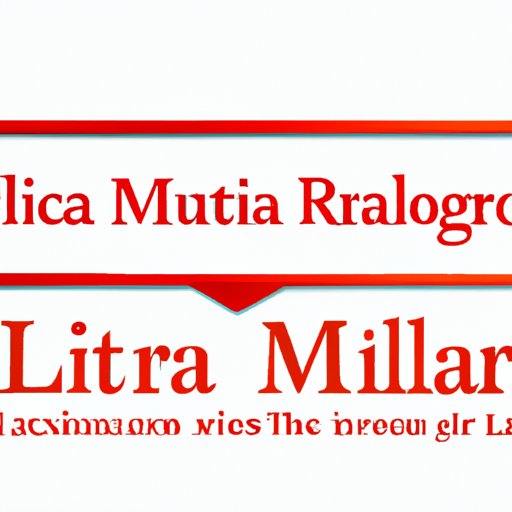
I. Introduction
Academic writing requires the use of proper citation styles in order to give credit to the sources of information used in a paper. One of the most commonly used citation styles in the humanities is the Modern Language Association (MLA) style. MLA citation is important because it provides a uniform and consistent method of citing sources, allowing audiences to easily locate the information being cited. In this article, we will cover the fundamentals of MLA citation, provide a step-by-step guide to citing sources, show how to avoid plagiarism, and share tips and tricks for success.
II. Fundamentals of MLA Citation
MLA citation developed out of the need to create a consistent and standardized system of citation for the humanities. MLA citation provides guidelines for formatting in-text citations and the works cited page. In order to properly format your paper according to MLA guidelines, you must understand the basic components of MLA citation.
In-text citations in MLA style include the author’s last name and the page number of the source you are using. For example: (Smith 48). The works cited page provides a list of all the sources you’ve cited in your paper. It is important to follow specific guidelines for formatting the citations in both in-text and works cited pages.
There are different types of sources that require different citation formats. Books, articles, and websites have unique formats for citation in MLA style. For example, books require the title of the book, the author’s name, the publisher, and the publication date. Websites require the title of the web page, the website name, the sponsor or publisher of the site, and the URL.
III. A Step-by-Step Guide to MLA Citation
Setting up your document for MLA style is the first step in proper MLA citation. The margins of your document, font size and style, line spacing and title block should all be formatted to meet MLA guidelines.
Citing different types of sources including books, articles, and websites in MLA style involves providing different pieces of information about each type of source. Each citation style requires specific punctuation as well.
Examples of correct MLA citation include:
Book:
Author’s Last Name, First Name. Title of Book. Publisher, Publication Date.
Article:
Author’s Last Name, First Name. “Title of Article.” Title of Journal, Volume number, Issue number, date of publication, page numbers.
Website:
Author’s Last Name, First Name (if available). “Title of Web Page.” Name of Website, Publisher, date published or updated (if available), URL.
IV. Avoiding Plagiarism: How to Do MLA Citation Like a Pro
Plagiarism is a serious offense in academic writing. Understanding what plagiarism is and how citation can prevent it is crucial. In order to avoid plagiarism, you need to paraphrase and summarize information from sources and then properly cite the original source.
If you’re struggling with citing a source, try using online citation generators or consult online resources for help. Some resources to help you with citation include the Online Writing Lab (OWL) and Purdue University’s Writing Lab.
V. MLA Citation Made Easy: Tips and Tricks for Success
Managing your sources and citations can be a time-consuming process. However, there are some time-saving tips you can use including labeling your sources, using citation software, and making use of citation management systems.
Citation software can be used to help automate the process of creating in-text citations and works cited pages. Citation management systems can help you keep track of your sources, and make it easier to create bibliographies and works cited pages.
When citing sources, be sure to avoid common mistakes such as incorrect formatting, improperly citing sources, or failing to include all required information.
VI. Getting the Details Right: A Comprehensive Guide to MLA Citation
Formatting rules for titles, dates, page numbers, and other important details matter, as they are all essential to correctly citing sources in MLA style. Additionally, complex sources such as interviews and government documents require special citation considerations.
Remember to proofread your works cited page to ensure correctness and consistency. MLA citation requires strict attention to detail, so double-checking your citations is a vital step in ensuring your sources are properly credited and organized.
VII. The Importance of MLA Citation: What You Need to Know as a Student or Researcher
The role of citation in academic writing and research cannot be overstated. Proper citation is crucial for building credibility, providing transparency, and acknowledging the work of others. Failure to properly cite sources can result in negative consequences such as plagiarism charges or lost credibility.
MLA citation is valuable because it allows writers to organize, analyze, and evaluate sources in a consistent manner. Following MLA guidelines ensures that your sources will be properly credited and that your work meets the requirements set forth by your instructor or publisher.
VIII. Exploring Different Citation Styles: A Closer Look at MLA Citation
MLA is just one of many citation styles used in academic writing. Other popular citation styles include American Psychological Association (APA) and Chicago style. While each style has its own unique characteristics, they all serve the same purpose of providing clear and concise citations to help readers locate the information being cited.
Ultimately, the choice of citation style depends on the requirements set forth by your instructor or publisher as well as the needs of your specific project.
IX. Conclusion
Proper citation is an essential component of academic writing and research. MLA citation provides a standardized method of citing sources and facilitating the exchange of ideas between scholars. In this article, we’ve covered the fundamentals of MLA citation, provided a step-by-step guide to citing sources, and shared tips and tricks for success. By understanding the importance of citation, you can become a more effective writer and researcher.
Remember to always double-check your citations and to consult reliable resources for guidance. With practice, you can become an expert in MLA citation and make your work stand out.




